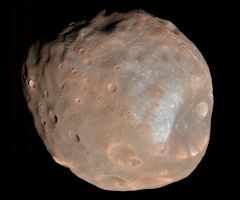|
|
The Martian Federation Society
Copyright 2017 by Raul E, Lopez, MD
| |
Facts About Mars
|
|
Size and Dimensions |
|
Radius of Mars:
2109mi, 3380.0 km.
|
|
Surface Area of Mars:
56 million square miles, 144 million square kilometers, 36 billion acres. This is
the same as the amount of land on Earth (57 million square miles). The Earth
of course, is larger, but the oceans cover 139 million square miles.
|
|
Gravity on Mars:
Gravity on Mars is 38% that of the Earth's. That means that a 150 pound
person would weigh 57 pounds on Mars.
Click here for a discussion about the effects of
low Martian gravity on colonists and how to prevent permanent damage.
|
|
Composition |
|
Atmospheric Composition:
CO2 95%, N2 2.7%, Ar 1.6%, CO 0.6%,
O2 0.15%, H2O 0.03%
|
|
Atmospheric Pressure:
This varies depending on the distance of Mars from the sun. The pressure
at the Viking Lander 2 site varied between 7.4 to 10.2 millibars. That is about
0.9% the pressure and density of the atmosphere on Earth at sea level and about
the same as that on Earth at about 20 miles (32 km) in altitude.
|
Soil Composition at Pathfinder Site:
O 44%, Si 20%, Fe 11%, Mn 6.4%, Mg 5.5%, Al 5.5%, Ca 3.4%, Na 3.2%, S 2.5%, P 1.0%,
Ti 0.7%, Cl 0.6%, k 0.6%, Cr 0.3%
Click here to view
a nice chart listing soil and rock elements by weight %.
|
|
Water on Mars:
Click here for a discussion about places where water
is found on Mars.
|
|
Climate and Temperature |
|
| |
Length of day and year:
The Martian day lasts 24.6598 hours, (24 hours, 39 minutes, 35.3 seconds). Martian
year lasts 686.98 Terran days, 668.60 Martian days.
|
|
Temperature on the Surface:
Mars Global Surveyor Thermal Emission Spectrometer data shows that surface
temperature varies from a high of about +20 degree Fahrenheit in the lower
latitudes to about a low of about -200 degrees Fahrenheit at the poles. The
temperature at the Pathfinder site varied between -60 at night to 20 during
early afternoon during the first few days of the Pathfinder misssion. Lowest
measured temperature on Earth is -120 in Antarctica.
Click here for a discussion about surviving the intense
cold on Mars.
|
Distance from Sun and Seasons:
Earth average distance from sun is 152 million km.
Mars is 245 million km from sun at its farthest poin (1.61 x Earth),
and 207 million km at its closest (1.36 x Earth).
Mars has an excentric orbit, so it is closest to the sun during the southern summer
and farther from the sun during the souther winter. This gives the southern
hemisphere a more extreme climate, making summers warmer and winters colder than
in the north. The northern hemisphere has a more constant temperature
with warmer winters and
cooler summers. It is probably the cooler summers that make the northern ice
cap the reservoir of water ice. Whatever water condenses in the southern ice cap
during the southern winter evaporates during the warm southern summers and migrates
to the north. The warmer brighter summers would make agriculture easier in the
south, but the winters would be more intolerable. Therefore, farming communities
might develop in the southern hemisphere while the larger population centers
might develop in the north where temperatures are more constant. Of course, Mars is
cold everywhere (see above).
|
|
Inclination of Equator to Orbit:
Mars is spining at an angle very similar to that of the Earth giving Mars seasons.
A person standing on Mars would see the sun at an angle similar to that on Earth
during the same time and season. However, the sun would be 2/3 as large, and half
bright.
Inclination of Earth to its orbit is 23.45 deg, and for Mars it is25.20 deg.
|
|
(More facts added every day) stay tuned!
|
| |
| |
top
|
|
|
|
|
|

